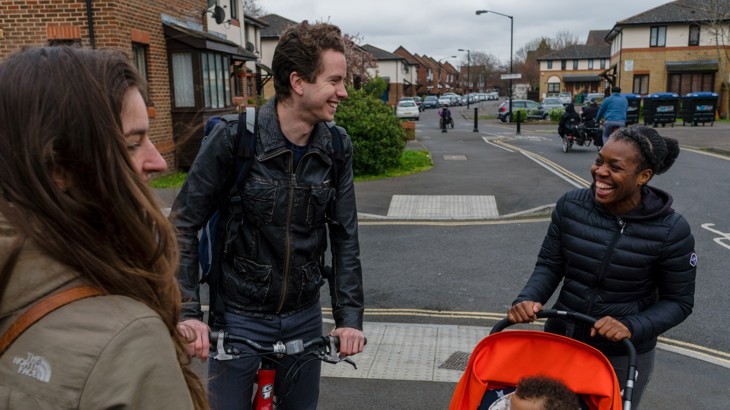Healthy Streets Design Check
Making better streets for people with Healthy Streets Design Check
We're working with Healthy Streets and local authorities to help urban designers, transport planners and highways teams create healthier streets for everyone.
Making our streets better places for people is vital to enabling more walking, wheeling and cycling
We know that people are more likely to walk, wheel or cycle if the environment around them feels safe, healthy, and enjoyable.
That's why we've worked with Lucy Saunders of Healthy Streets, and a number of local authorities, to develop the Healthy Streets Design Check tool.
The Healthy Streets Design Check tool was developed with input and feedback from designers, engineers, policy makers and public health specialists.
Sustrans provided specialist input on designing for cycling.
It's the first tool of its kind to be developed outside of London and can be applied to a design on any street across England.
Embedding public health in transport, public realm and planning
The Healthy Streets Approach is a human-centred framework for embedding public health in transport, public realm and planning.
The Healthy Streets Design Check tool is used to score the health of existing streets against the 10 Healthy Streets Indicators and then measure how different design interventions can improve them for the health of the population.

Being able to quantify how design features may improve any potential street is really valuable.
And, the tool goes further: it also allows us to identify Healthy Streets Indicators that haven’t been improved by a design, so providing an opportunity to make further enhancements.
How Sustrans is using the Healthy Streets Design Check tool to help local authorities
Our team of designers use the Healthy Streets Design Check tool to check the design work we produce for local authorities through our Local Cycling and Walking Infrastructure Plan (LCWIP) support programme.
Funded by the Department for Transport, we provide support to local authorities, helping them develop a pipeline of walking and cycling schemes from their LCWIPs. We produce outline designs, visualisations and outline business cases for those schemes.
We’re piloting the Healthy Streets Design Check Tool on over 30 schemes, from Cornwall to Cumbria.
This means that the schemes we design will not only comply with the latest government design guidance (Local Transport Note 1/20). They will also make further improvements to tackle public health.

Small changes can make a big difference to the health of our streets
The Healthy Streets Design Check tool allows us to address the whole street environment by making small changes to overall design projects, rather than focusing only on the specific piece of infrastructure we’re designing.
Some of the changes that can make a big difference include:
- improving pedestrian conditions when designing a cycleway, such as introducing public seating, dropped kerbs, footway improvements and better crossings
- proposing green infrastructure to minimise surface water run-off, improving resilience during extreme weather events
- improving shade and shelter to maximise the comfort of sustainable transport users
- a greater focus on reducing traffic volumes and speeds, which most directly impact the score of the scheme
- understanding that traffic volume "peaks" and traffic speed "peaks" may not necessarily be where you think they are
- improving lighting, which gives many people more confidence to travel independently.
Want to find out more about how we can help your team? Email your Sustrans’ regional or national team
Find out more about the Healthy Streets Design Check tool
Learn more about Sustrans’ work to deliver Healthy Streets in London


